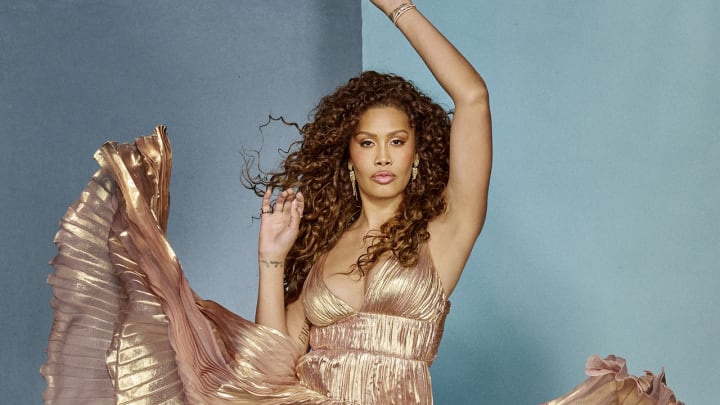Leyna Bloom Celebrates Black Queer Experience in ‘House on Fire’

Leyna Bloom may be a two-time SI Swimsuit Issue cover model, but she’s also an actress, activist and dancer. The Chicago native is the star of House on Fire, a new reality television series premiering on WOW Presents Plus today. The eight-part docuseries follows New York’s iconic House of Miyake-Mugler, of which Bloom is a proud member.
Bloom was first introduced to the ballroom scene by a high school classmate who suggested she watch the 1990 documentary Paris Is Burning. The film, which documented New York City’s drag ballroom scene during the ’80s, changed the trajectory of Bloom’s life.
“Once I watched that movie, my life completely changed,” the model and dancer says of the Jennie Livingston-directed project. “I immediately was like, ‘Oh my God, these are my people. This is where I need to be. This is where I belong. This is what’s been missing for me.‘“
Finding community through ballroom
Ballroom, an underground LGBTQ circuit composed of Black and Brown individuals, got its start in New York City by Crystal LaBeija, a Black transgender woman who founded the House of LaBeija in the late 1960s. Bloom notes that until then, it was virtually unheard of for Black drag queens or trans women to participate in the scene over their white counterparts—and LaBeija changed everything.
“For me, ballroom was a refuge,” Bloom shares. “It was a place where I found community. It was my original runway. It was kind of like etiquette school for me, learning about how to walk runway and how to wear clothes ... and how to apply that to your own personal body shape, and how to apply it to your own personal essence, and understanding the power of pheromones and energy. For a Black queer person who is often ostracized, or in positions where they don’t have opportunity or have resources to opportunity, ballroom is a safe place for people like myself to go to find community and find familyhood and build chosen families.”
New York’s ballroom scene is divided into different houses, the majority of which are named after various high-end fashion designers. Each house, which is led by a “mother” and “father,” is then composed of individuals who compete against other houses in categories like voguing, runway and face, the latter of which is Bloom’s category. The five elements of face that participants are judged on include nose, lips, smile, structure and personality, according to Bloom.
“Basically you do these subtle movements with your hands or with your aura or with your energy,” she explains. “It’s like dancing with your face and you’re showing different shapes and you’re showing your structure and hyper amplifying that your face is beautiful.”
And while houses do compete against each other, ballroom is all about creating community and fostering relationships within houses. The community has been a life-changing one for Bloom, who was previously taken in by household father Yusef Mugler when she was experiencing homelessness.
“[Through ballroom] I’ve learned that everyone needs a home and everyone needs to feel loved,” Bloom expresses. “Often queer folks, Black folks, Black and brown bodies, trans bodies essentially, they get kicked out on the streets and they don’t have access to resources. Ballroom gives them that refuge, gives them a home, gives them food, gives them guidance, gives them mentorship, and gives them a family, a structure. Ballroom is surrounded by a mother and father, and in the house of mother and father, they take care of their children. It’s definitely a place full of love and a place full of opportunity.”
The iconic House of Miyake-Mugler
Bloom tells us that House on Fire is a manifestation she and Belgian producer Loïc Maes brought to life after she expressed a desire to create a community-oriented, educational program about ballroom culture that would elevate queer stories. The docuseries focuses on the House of Miyake-Mugler’s nine members, including household heads Yusef Mugler and Exotic Mugler, along with members Bloom, Tati, Roz, Brooklyn, Lolita, AJ and Chanel.
Bloom, who joined the House of Miyake-Mugler in 2014, briefly took some time away from the house five years after she joined. Her storyline on the show largely focuses on her return, and she also opens up about her desire to become a mother.
House on Fire’s first two episodes premiere today, serving as the perfect way to kick off Pride Month. And while she says it’s “scary” to be this raw, real and unscripted in front of the world, Bloom is proud of putting her vulnerability on display.
“[The] show is about celebrating Black queer experiences that have been kind of erased or eradicated or in some aspects pushed in the background and kind of like hidden from society,” Bloom explains. “This is our opportunity to show us that we do exist and we are still here and we all can exist together.”
Subscribe to WOW Presents Plus here for $4.99/month or $49.99/year to tune in to House on Fire. New episodes release every Tuesday at 6 p.m. ET.
